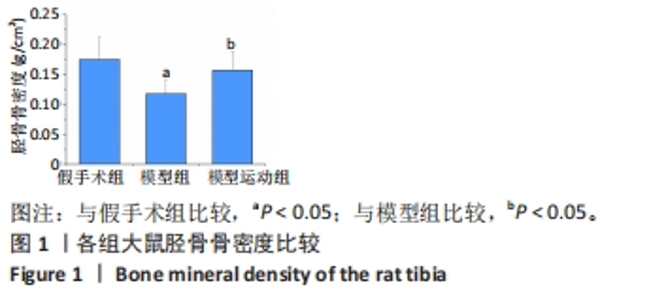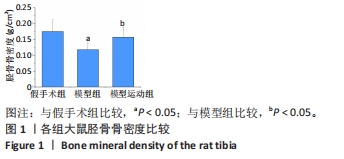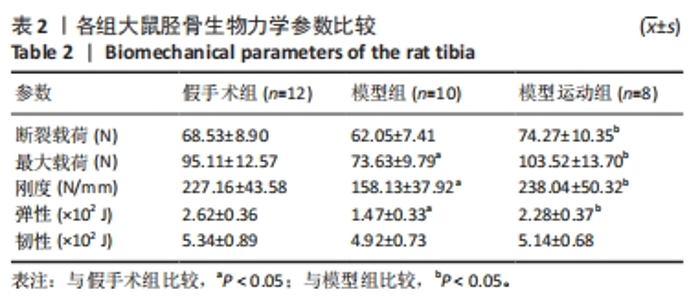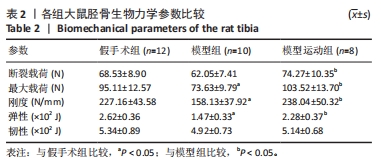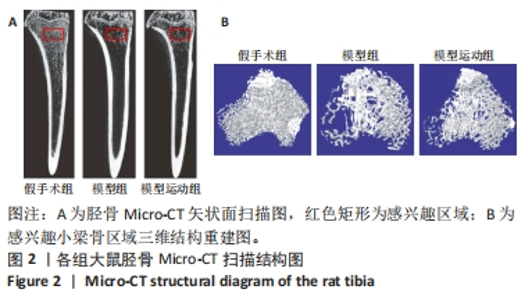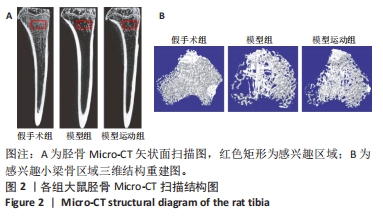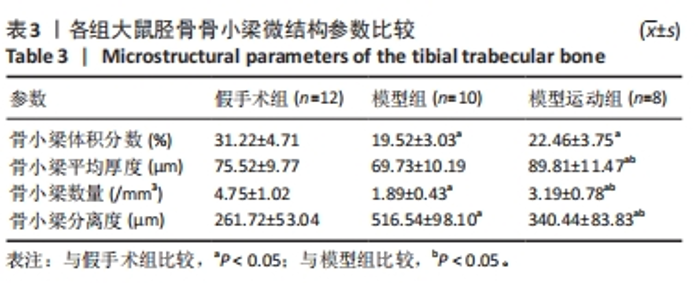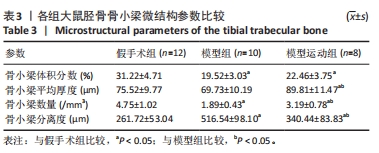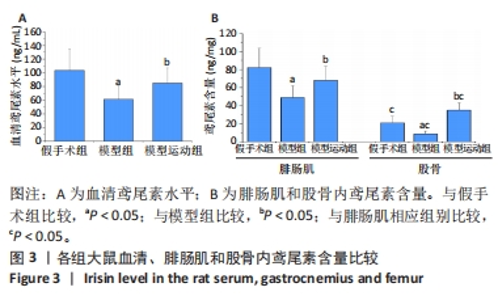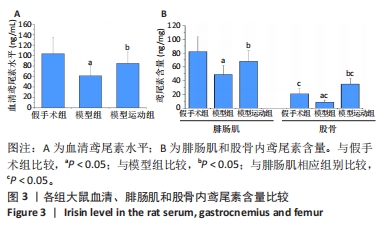Chinese Journal of Tissue Engineering Research ›› 2024, Vol. 28 ›› Issue (32): 5141-5147.doi: 10.12307/2024.498
Previous Articles Next Articles
Mechanisms by which high-intensity interval training influences bone health in a rat model of postmenopausal osteoporosis
Yang Rui1, Cao Kai2, Zhao Wei2, Wang Qingbo3, Lu Chunmin3, Zhang Yan3
- 1School of Physical Education, China University of Mining and Technology, Xuzhou 221116, Jiangsu Province, China; 2Logistics University of Chinese People’s Armed Police Forces, Tianjin 300309, China; 3Department of Physical Education, Guangxi University of Chinese Medicine, Nanning 530021, Guangxi Zhuang Autonomous Region, China
-
Received:2023-08-31Accepted:2023-09-25Online:2024-11-18Published:2023-12-28 -
Contact:Zhang Yan, Master, Associate professor, Department of Physical Education, Guangxi University of Chinese Medicine, Nanning 530021, Guangxi Zhuang Autonomous Region, China -
About author:Yang Rui, Master, Assistant researcher, School of Physical Education, China University of Mining and Technology, Xuzhou 221116, Jiangsu Province, China -
Supported by:Guangxi Education Science "13th Five-Year Plan" Project, No. 2017C386 (to ZY)
CLC Number:
Cite this article
Yang Rui, Cao Kai, Zhao Wei, Wang Qingbo, Lu Chunmin, Zhang Yan. Mechanisms by which high-intensity interval training influences bone health in a rat model of postmenopausal osteoporosis[J]. Chinese Journal of Tissue Engineering Research, 2024, 28(32): 5141-5147.
share this article
Add to citation manager EndNote|Reference Manager|ProCite|BibTeX|RefWorks
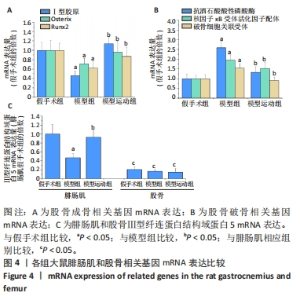
2.6 各组大鼠股骨与腓肠肌内相关因子mRNA表达比较 股骨成骨与破骨相关因子mRNA表达:与假手术组比较,模型组大鼠股骨Ⅰ型胶原、Osterix、Runx2 mRNA表达降低(P < 0.05),抗酒石酸酸性磷酸酶、核因子κB受体活化因子配体、破骨细胞关联受体mRNA表达升高(P < 0.05);与模型组比较,模型运动组大鼠股骨Ⅰ型胶原、Osterix、Runx2 mRNA表达升高(P < 0.05),抗酒石酸酸性磷酸酶、核因子κB受体活化因子配体、破骨细胞关联受体mRNA表达降低(P < 0.05),见图4A、B。 腓肠肌和股骨Ⅲ型纤连蛋白结构域蛋白5mRNA表达:各组大鼠股骨Ⅲ型纤连蛋白结构域蛋白5 mRNA表达明显低于腓肠肌(P < 0.05);与假手术组比较,模型组大鼠腓肠肌Ⅲ型纤连蛋白结构域蛋白5 mRNA表达降低(P < 0.05);与模型组比较,模型运动组大鼠腓肠肌Ⅲ型纤连蛋白结构域蛋白5 mRNA表达升高(P < 0.05)。各组大鼠股骨Ⅲ型纤连蛋白结构域蛋白5 mRNA表达比较差异无显著性意义(P > 0.05),见图4C。"
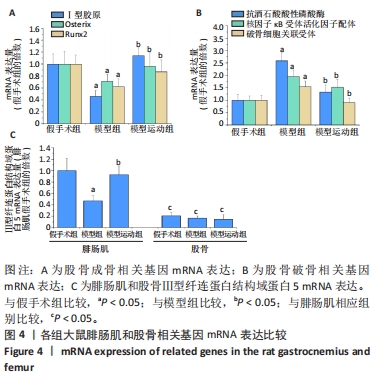
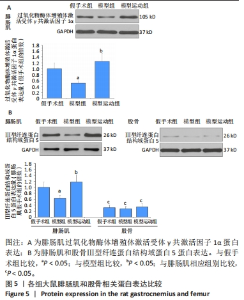
2.7 各组大鼠股骨与腓肠肌相关蛋白表达比较 腓肠肌过氧化物酶体增殖体激活受体γ共激活因子1α蛋白表达:与假手术组比较,模型组大鼠腓肠肌过氧化物酶体增殖体激活受体γ共激活因子1α蛋白表达降低(P < 0.05);与模型组比较,模型运动组大鼠腓肠肌过氧化物酶体增殖体激活受体γ共激活因子1α蛋白表达升高(P < 0.05),见图5A。 腓肠肌和股骨Ⅲ型纤连蛋白结构域蛋白5蛋白表达:各组股骨Ⅲ型纤连蛋白结构域蛋白5蛋白表达量明显低于腓肠肌(P < 0.05);与假手术组比较,模型组大鼠腓肠肌Ⅲ型纤连蛋白结构域蛋白5蛋白表达下降(P < 0.05);与模型组比较,模型运动组大鼠腓肠肌Ⅲ型纤连蛋白结构域蛋白5蛋白表达升高(P < 0.05);各组大鼠股骨Ⅲ型纤连蛋白结构域蛋白5蛋白表达比较差异无显著性义(P > 0.05),见图5B。"
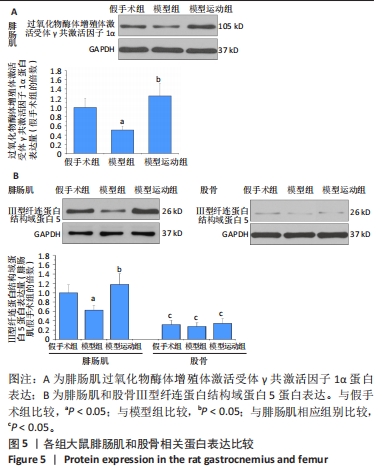
| [1] BROWN JP. Long-term treatment of postmenopausal osteoporosis. Endocrinol Metab (Seoul). 2021;36(3):544-552. [2] WOJTYS EM. Bone health. Sports Health. 2020;12(5):423-424. [3] KEMMLER W, SHOJAA M, KOHL M, et al. Effects of different types of exercise on bone mineral density in postmenopausal women: A systematic review and meta-analysis. Calcif Tissue Int. 2020;107(5): 409-439. [4] 陈演,邱俊强,于涛,等.肌肉-器官交互作用:运动诱导的肌肉因子研究进展[J].中国运动医学杂志,2022,41(11):887-895. [5] 张艳,李荣源,黄华生,等.不同运动方式在缓解期溃疡性结肠炎患者康复治疗中的作用[J].中国体育科技,2016,52(5):59-67. [6] 张艳,何瑞波,王庆博,等.不同负荷量有氧运动对肥胖大鼠骨骼肌炎症反应和胰岛素信号途径的影响及机制[J].中国组织工程研究,2023,27(8):1237-1244. [7] 孙园,王庆博,皮亦华,等.早期和晚期有氧运动对野百合碱诱导肺动脉高压大鼠右心衰竭的影响[J]. 中国组织工程研究,2024, 28(2):177-185. [8] 原发性骨质疏松症诊疗指南(2022)[J].中华骨质疏松和骨矿盐疾病杂志,2022,15(6):573-611. [9] THIVEL D, MASURIER J, BAQUET G, et al. High-intensity interval training in overweight and obese children and adolescents: systematic review and meta-analysis. J Sports Med Phys Fitness. 2019;59(2):310-324. [10] JACOBS RA, FLüCK D, BONNE TC, et al. Improvements in exercise performance with high-intensity interval training coincide with an increase in skeletal muscle mitochondrial content and function. J Appl Physiol (1985). 2013;115(6):785-793. [11] LITTLE JP, GILLEN JB, PERCIVAL ME, et al. Low-volume high-intensity interval training reduces hyperglycemia and increases muscle mitochondrial capacity in patients with type 2 diabetes. J Appl Physiol (1985). 2011;111(6):1554-1560. [12] CHRISTENSEN PM, KRUSTRUP P, GUNNARSSON TP, et al. VO2 kinetics and performance in soccer players after intense training and inactivity. Med Sci Sports Exerc. 2011;43(9):1716-1724. [13] MIGUET M, FEARNBACH NS, METZ L, et al. Effect of HIIT versus MICT on body composition and energy intake in dietary restrained and unrestrained adolescents with obesity. Appl Physiol Nutr Metab. 2020; 45(4):437-445. [14] HUNSCHEDE S, KUBANT R, AKILEN R, et al. Decreased appetite after high-intensity exercise correlates with increased plasma interleukin-6 in normal-weight and overweight/obese boys. Curr Dev Nutr. 2017;1(3): 398-414. [15] COLPITTS BH, RIOUX BV, EADIE AL, et al. Irisin response to acute moderate intensity exercise and high intensity interval training in youth of different obesity statuses: A randomized crossover trial. Physiol Rep. 2022;10(4):151-168. [16] NOLL M, MENDONçA CR, RODRIGUES A, et al. Narrative review of the influence of high-intensity interval training on adolescents’ bone health: commentary and perspectives. Transl Pediatr. 2021;10(1): 160-164. [17] 刘玉琳,解浩东.全身振动训练联合正弦交变电磁场对去卵巢骨质疏松大鼠骨密度、骨代谢指标的影响研究[J].中国骨质疏松杂志, 2019,25(7):947-953. [18] 袁国强,秦永生,彭朋.高强度间歇运动对自发性高血压模型大鼠病理性心脏肥大的影响及机制[J]. 中国组织工程研究,2020,24(23): 3708-3715. [19] HOSSEINI SA, SALEHI O, KEIKHOSRAVI F, et al. Mental health benefits of exercise and genistein in elderly rats. Exp Aging Res. 2022;48(1):42-57. [20] GAUTVIK KM, GüNTHER CC, PRIJATELJ V, et al. Distinct subsets of noncoding rnas are strongly associated with BMD and fracture, studied in weight-bearing and non-weight-bearing human bone. J Bone Miner Res. 2020;35(6):1065-1076. [21] 卜淑敏,杨涵,韩天雨.不同干预疗法对去卵巢骨质疏松大鼠骨微结构影响的对比研究[J].中国运动医学杂志,2016,35(3):257-261. [22] GOMES GJ, CARLO R, SILVA M, et al. Swimming training potentiates the recovery of femoral neck strength in young diabetic rats under insulin therapy. Clinics (Sao Paulo). 2019;74(10):829-835. [23] TASHAKOR S, BAGHERIAN B, SALMANPOUR Z, et al. The effect of a training program on the self-care efficacy of hemodialysis patients with mineral and bone disorders: A quasi-experimental study. Health Sci Rep. 2023;6(7):1429-1440. [24] PENG X, GAO B, WANG X, et al. Hyperbaric oxygen and treadmill exercise partially prevented bone loss and bone microarchitecture deterioration in ovariectomized rats. Diving Hyperb Med. 2023;53(2): 111-119. [25] ABDELFATTAH ABULFADLE K, REFAAT ABDELKADER ATIA R, OSAMA MOHAMMED H, et al. The potential anti-osteoporotic effect of exercise-induced increased preptin level in ovariectomized rats. Anat Sci Int. 2023;98(1):22-35. [26] JOTA-BAPTISTA C, FAUSTINO-ROCHA AI, FARDILHA M, et al. Effects of testosterone and exercise training on bone microstructure of rats. Vet World. 2022;15(3):627-633. [27] ABE K, MIYAKOSHI N, KASUKAWA Y, et al. Effects of teriparatide and low-intensity aerobic exercise on osteopenia in type 2 diabetes mellitus rats. J Bone Miner Metab. 2022;40(2):229-239. [28] HAJISADEGHI H, AZARBAYJANI MA, VAFAEENASAB M, et al. Effect of regular resistance exercise, vitamin d, and calcium supplements on the bone mineral content and density in postmenopausal model of rats: an experimental study. Int J Reprod Biomed. 2021;19(1):63-74. [29] YUASA Y, MIYAKOSHI N, KASUKAWA Y, et al. Effects of bazedoxifene and low-intensity aerobic exercise on bone and fat parameters in ovariectomized rats. J Bone Miner Metab. 2020;38(2):179-187. [30] YIN X, ZHOU C, LI J, et al. Autophagy in bone homeostasis and the onset of osteoporosis. Bone Res. 2019;7(15):28-39. [31] GOPINATHAN G, LUAN X, DIEKWISCH T. Epigenetic repression of RUNX2 and OSX promoters controls the nonmineralized state of the periodontal ligament. Genes (Basel). 2023;14(1):201-217. [32] AMIN N, BOCCARDI V, TAGHIZADEH M, et al. Probiotics and bone disorders: the role of RANKL/RANK/OPG pathway. Aging Clin Exp Res. 2020;32(3):363-371. [33] QING HONG Z, MENG TAO L, YI Z, et al. The effect of rotative stress on CAII, Fas, FasL, OSCAR, and TRAP gene expression in osteoclasts. J Cell Biochem. 2013;114(2):388-397. [34] BAO JF, SHE QY, HU PP, et al. Irisin, a fascinating field in our times. Trends Endocrinol Metab. 2022;33(9):601-613. [35] LI G, ZHANG L, WANG D, et al. Muscle-bone crosstalk and potential therapies for sarco-osteoporosis. J Cell Biochem. 2019;120(9):14262-14273. [36] POLYZOS SA, ANASTASILAKIS AD, EFSTATHIADOU ZA, et al. Irisin in metabolic diseases. Endocrine. 2018;59(2):260-274. [37] IEMURA S, KAWAO N, OKUMOTO K, et al. Role of irisin in androgen-deficient muscle wasting and osteopenia in mice. J Bone Miner Metab. 2020;38(2):161-171. [38] KAWAO N, MORITAKE A, TATSUMI K, et al. Roles of irisin in the linkage from muscle to bone during mechanical unloading in mice. Calcif Tissue Int. 2018;103(1):24-34. [39] COLAIANNI G, MONGELLI T, CUSCITO C, et al. Irisin prevents and restores bone loss and muscle atrophy in hind-limb suspended mice. Sci Rep. 2017;7(1):2811-2825. [40] CHEN X, SUN K, ZHAO S, et al. Irisin promotes osteogenic differentiation of bone marrow mesenchymal stem cells by activating autophagy via the Wnt/β-catenin signal pathway. Cytokine. 2020;136(5):155-168. [41] ZHANG J, VALVERDE P, ZHU X, et al. Exercise-induced irisin in bone and systemic irisin administration reveal new regulatory mechanisms of bone metabolism. Bone Res. 2017;5(7):160-172. |
| [1] | Wang Ji, Zhang Min, Li Wenbo, Yang Zhongya, Zhang Long. Effect of aerobic exercise on glycolipid metabolism, skeletal muscle inflammation and autophagy in type 2 diabetic rats [J]. Chinese Journal of Tissue Engineering Research, 2024, 28(8): 1200-1205. |
| [2] | Wei Juan, Li Ting, Huan Mengting, Xie Ying, Xie Zhouyu, Wei Qingbo, Wu Yunchuan. Mechanism by which static exercise improves insulin resistance in skeletal muscle of type 2 diabetes [J]. Chinese Journal of Tissue Engineering Research, 2024, 28(8): 1271-1276. |
| [3] | Kong Jianda, Mu Yujing, Zhu Lei, Li Zhilin, Chen Shijuan. Mechanism of satellite cell regulation and its role in ecological niche signaling during skeletal muscle regeneration [J]. Chinese Journal of Tissue Engineering Research, 2024, 28(7): 1105-1111. |
| [4] | Yang Yifeng, Huang Jian, Ye Nan, Wang Lin. Ischemia-reperfusion injury in total knee arthroplasty [J]. Chinese Journal of Tissue Engineering Research, 2024, 28(6): 955-960. |
| [5] | Liu Zhiyang, Fu Zeting, Xia Yu, Ding Haili. The role of BMAL1 and MyoD in exercise-induced skeletal muscle damage [J]. Chinese Journal of Tissue Engineering Research, 2024, 28(4): 510-515. |
| [6] | Xu Rui, Li Yanyan, Xu Hong. Effect and mechanism of short-chain fatty acids in aged rats with sarcopenia [J]. Chinese Journal of Tissue Engineering Research, 2024, 28(32): 5172-5176. |
| [7] | Li Shudong, Liang Xuezhen, Luo Di, Li Jiacheng, Yan Bozhao, Li Gang. Identification of biomarkers associated with ferroptosis and pyroptosis for the potential diagnosis of postmenopausal osteoporosis [J]. Chinese Journal of Tissue Engineering Research, 2024, 28(28): 4511-4515. |
| [8] | Zhang Shudong, Huang Yilin, Yao Qi. Punicalagin treats postmenopausal osteoporosis by promoting osteogenesis [J]. Chinese Journal of Tissue Engineering Research, 2024, 28(26): 4101-4105. |
| [9] | Yang Zongrui, Ge Haiya, Shi Jinyu, Wang Zhengming, Wang Yuanyuan, Li Zhengyan, Du Guoqing, Zhan Hongsheng. Characteristic changes in morphology and function of skeletal muscles in a rat model of “tendon off-position” [J]. Chinese Journal of Tissue Engineering Research, 2024, 28(26): 4170-4177. |
| [10] | Yang Shanshan, Ouyang Renjun, Tian Jia, Linghu Min, Wang Zhen, Yang Xiaohong. Detection of immune-related cytokines of bone marrow mesenchymal stem cells in postmenopausal osteoporosis mice by antibody chip and analysis of key differential genes [J]. Chinese Journal of Tissue Engineering Research, 2024, 28(25): 3947-3954. |
| [11] | Yu Yangyi, Lian Qiang, Wu Jianqun, Zhang Xuan, Ren Jinke, Li Guangheng. Cell-of-origin for heterotopic ossification induced by bone morphogenetic protein 4 in skeletal muscle [J]. Chinese Journal of Tissue Engineering Research, 2024, 28(25): 4034-4040. |
| [12] | Xie Yingao, Kong Jianda, Chen Yun, Li Zhilin, Xu Peng. Biological mechanism of satellite cell aging in skeletal muscles and potential coping strategies [J]. Chinese Journal of Tissue Engineering Research, 2024, 28(25): 4094-4100. |
| [13] | Kong Jianda, Xie Yingao, Chen Shijuan, Zhu Lei. Blood flow restriction training interventions for sarcopenia in older adults: biological mechanisms and proposed application protocols [J]. Chinese Journal of Tissue Engineering Research, 2024, 28(23): 3743-3750. |
| [14] | Ji Weixiu, Bai Yi, Wang Shuo, Zhao Yungang. Protective effect and mechanism of 3-nitro-N-methyl salicylamide on the skeletal muscle of rats with limb ischemia-reperfusion injury [J]. Chinese Journal of Tissue Engineering Research, 2024, 28(20): 3164-3169. |
| [15] | Wang Jingfeng, Wen Dengtai, Wang Shijie, Gao Yinghui. Atg-mediated autophagy, exercise and skeletal muscle aging [J]. Chinese Journal of Tissue Engineering Research, 2024, 28(2): 295-301. |
| Viewed | ||||||
|
Full text |
|
|||||
|
Abstract |
|
|||||
